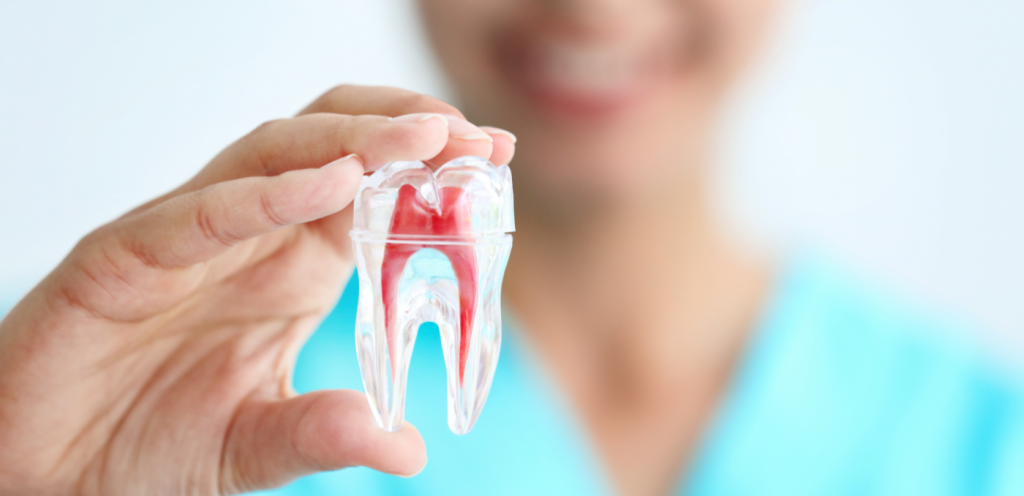BRIDGE VS. IMPLANT
October 28, 2019

Over the past few weeks I have had numerous new and existing patients who have had the need to replace single and multiple teeth. Based on the conversations I have had with these patients, there seems to be some common misconceptions about replacing teeth. I would like to share my thought process that I communicate with patients when they are forced to decide between different treatment options.
Let me start by using an example of a new patient I had in yesterday. The patient presented with the chief complaint of pain. The diagnosis was an infection of a previously root canal treated tooth which was deemed non-restorable. The only treatment was extraction. The teeth adjacent to this tooth are in good condition. There are four treatment options: extract and leave the space, extract and replace missing tooth with a removable appliance (partial denture), extract and do a fixed, cemented bridge (non-removable), extract and replace missing tooth with a dental implant.
Extracting the bad tooth and leaving the space is always an option. There are, of course, esthetic concerns as well as concerns about other teeth moving and loss of function. Replacing the missing tooth with a removable partial denture is an option, but is not one that most people choose, due to the fact that they have to wear something in their mouth. That leaves the last two options that most people contemplate: a bridge vs. a dental implant.
When I started practice, the standard of care was to replace the missing tooth with a bridge. A bridge is a laboratory fabricated restoration where the teeth on either side of the missing tooth (abutments) are prepared for crowns. An impression is taken of the prepared teeth, and the final product, a one-piece “3-tooth” porcelain bridge, is cemented onto the two teeth that were prepared. The advantages of this are: typically can done quicker than an implant, and if the abutment teeth need crowns anyway, all is accomplished with that one procedure.
One major disadvantage is that if you get decay on one of the abutment teeth, the entire bridge is typically lost. So, if you are prone to decay (especially if you do not visit the dentist on a regular basis), a bridge is probably not the best solution. Another disadvantage is that if the abutment teeth do not “need” crowns, a bridge requires perfectly good teeth to be ground-down. Because the bridge is one piece, flossing requires a special tool to thread the floss under the bridge.
Today, I would consider a dental implant to be the standard of care. A dental implant is a titanium “post” that replaces the root of the missing tooth. A single crown is then placed on that “post”. The procedure is typically less invasive than removal of a tooth. You cannot get decay on a dental implant. If something goes wrong with one of the teeth on either side of the dental implant, you only have to deal with the one tooth and not three teeth as in the example of the bridge. The teeth are all separate so flossing is normal. The cost of a single dental implant vs. a 3-unit bridge is in the same ballpark.
There are other things to consider. I encourage your questions.
Dr. St. Clair maintains a private dental practice in Rowley and Newburyport dedicated to health-centered family dentistry. If there are certain topics you would like to see written about or questions you have please email them to him at jpstclair@stclairdmd.com. You can view all previously written columns at www.jpeterstclairdentistry.com/blog.
5 Tips to Protect Your Child from Troublesome Halloween Cavities!
October 22, 2019

We all know that Halloween is known for the consumption of loads and loads of candy. While this may be a child’s dream come true, there are consequences of overindulging in sweet treats. One of them is the development of cavities. So does that mean that your child has to skip all the festivities? Your dentist says, “No.” As you continue reading, you’ll learn about 5 Halloween candy tips that will protect your little one’s oral health while allowing for a joyous evening.
(more…)ROOT CANAL RESEARCH
October 21, 2019

Patients often ask about whether there are any new technologies on the horizon, or currently in use, to help with different dental problems. There are many concepts being developed that could revolutionize the way care is delivered. My favorites are those that help prevent things, such as root canals.
Many people have felt the jolting sensation of a sharp pain in a tooth after drinking cold beverages. A tooth is made up of tubules, microscopic channels that extend from the inner layer of tooth called dentin, all the way to the center of the tooth containing the nerve. The sensation comes from the temperature travelling through open tubules, either from damaged dentin caused by decay or exposed dentin from recession of the gums.
If the sensation goes away in a split second the diagnosis is called reversible pulpitis (inflammation in the nerve of the tooth). If the pain lingers for more than a few seconds the diagnosis may be irreversible pulpitis and the treatment sometimes requires a root canal procedure to remove the damaged nerve.
Research being conducted at the University of Maryland School of Dentistry could provide dentists with a much less invasive treatment for pulpitis. Researchers are developing a new, patent-pending technique to deliver medication directly to the center of a tooth. The technique uses strong magnetic fields to move microscopic particles through the tooth’s dentin and into the pulp.
The research uses the tubules of the tooth as a vehicle to deliver medication that could reduce inflammation or treat infection. The technique would attach medication to nanoparticles. By creating the nanoparticles out of a magnetic substance, such as iron, the researchers can use a magnetic field to push those particles, and the attached medication, through the tubules and into the pulp.
Delivering steroid medication using these magnetic nanoparticles could treat inflammation in the pulp. An antibiotic could also be delivered to reduce the infection, or a local anesthetic could be used to anesthetize a tooth.
The research has shown that, even though the nanoparticles are tiny, they are able to deliver a large enough dose for medications to be effective. Studies are currently being conducted on extracted human teeth to determine the optimal size for the nanoparticles and the most effective biocompatible coating. By covering the particles with a biocompatible substance, starch for example, the body’s immune system won’t attack the nanoparticles.
Dentists have been treating inflammation of the pulp the same way for a long time, which is to remove the pulp of the tooth. When the pulp of the tooth is removed, the space the nerve occupied has to be filled with a material to prevent bacterial growth. Although effective, this devitalizes the tooth and comes with its own set of potential problems over time. These problems include a weakened tooth with a higher potential for fracture, as well as a much higher risk for recurrent infection.
This new research is a possible contemporary solution to an age-old problem. By delivering medication directly to the area of the tooth that gives the tooth its vitality, it could prevent the need for many root canals.
Dr. St. Clair maintains a private dental practice in Rowley and Newburyport dedicated to health-centered family dentistry. If there are certain topics you would like to see written about or questions you have please email them to him at jpstclair@stclairdmd.com. You can view all previously written columns at www.jpeterstclairdentistry.com/blog.
THE INFORMATION HIGHWAY
October 15, 2019

Do you pay much attention to those cards in a hotel room asking you to reuse your towels? Many people don’t. But one researcher, Robert Cialdini, a University of Phoenix professor and the author of Influence: The Psychology of Persuasion, found a way to get guests to cooperate. He created a card saying that most guests who stayed “in this room” reused their towels. The response beat the typical compliance rate by 33 percent.
Cialdini calls this the “Social Proof Effect,” and it is a powerful force in our increasingly connected culture. It’s not about peer pressure. It’s about peer information, and how we behave and make decisions based on the standards, expectations, and recommendations of our social groups. It’s why people share TV talk around the water cooler, and it explains the popularity of social media like Facebook and Twitter, which make it easier than ever to be plugged into what our peers are thinking and doing.
Many dental offices use social media as a way to connect with patients and bring discussions of dental issues into their cyber-world. It’s not for everyone, but there are many patients who like and benefit from it.
The same thing goes for “Dr. Google”. It is just another way to get information. Many people use Google to help self-diagnose. Any information helps make you more informed and aids in making decisions when it comes to choices. With many people it’s reassuring—a way of validating that the choice they’re about to make has been endorsed by people like them in similar circumstances.
More and more patients are coming into the office armed with information they have collected from their own web searches. Many times it is good information, which stimulates good discussion. Other times the information brought to the table is misguided information, which can stimulate good discussion, but can also confuse people.
One potential problem is that patients often think that if something didn’t work out for someone they know, it is not right for their particular situation. For example, I have had patients come in and say, “My friend had a miserable time with a dental implant. I don’t want a dental implant.” In this situation it takes a lot more nurturing and education to convince someone that a dental implant is right for them. Sure, there are people who have problems, but there are many more people who have had positive experiences and wouldn’t want anything else.
This is where spending time one on one with patients is so important. TIME is the most precious gift a healthcare provider can give to his or her patients. Spending time to educate people allows them to make the best decisions for themselves. The trend is to spend less time with patients. There may be many reasons for this, but one definite one is the pressure from insurance companies to control costs. Who wins in that situation?
Whatever way you get your information, take the time to thoroughly discuss it with your healthcare provider. Bring the information you find and incorporate it into the conversation. Your healthcare provider should be YOUR biggest advocate. It should be a trusting and transparent relationship. If it doesn’t seem that way, maybe you should consider your alternatives.
Dr. St. Clair maintains a private dental practice in Rowley and Newburyport dedicated to health-centered family dentistry. If there are certain topics you would like to see written about or questions you have please email them to him at jpstclair@stclairdmd.com. You can view all previously written columns at www.jpeterstclairdentistry.com/blog.







